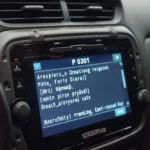The obd2 connector 60 ohm resistor plays a crucial role in the functionality of your vehicle’s On-Board Diagnostics (OBD) system. This seemingly small component ensures stable communication between your vehicle’s electronic control unit (ECU) and diagnostic tools, like OBD2 scanners. Understanding its function can help you troubleshoot potential issues and ensure accurate diagnostic readings.
What is an OBD2 Connector 60 Ohm Resistor?
The 60 ohm resistor within the OBD2 connector is a critical part of the Controller Area Network (CAN) bus system, the communication backbone of modern vehicles. It acts as a terminator, absorbing signal reflections and preventing them from interfering with data transmission. This ensures clear and reliable communication between the various modules within the car and the diagnostic tool plugged into the OBD2 port. Without this resistor, the CAN bus can become unstable, leading to erratic readings or communication failures.
Why is the 60 Ohm Resistor Important?
The obd2 connector 60 ohm resistor isn’t just a random component; it’s essential for several reasons:
- Data Integrity: It maintains the integrity of data transmitted over the CAN bus, preventing errors and ensuring accurate diagnostic results.
- Communication Stability: The resistor stabilizes the CAN bus, preventing signal reflections that can disrupt communication.
- Preventing Diagnostic Errors: A faulty or missing resistor can lead to incorrect fault codes, hindering proper diagnosis.
- Protecting Electronic Components: By absorbing signal reflections, the resistor protects sensitive electronic components from damage.
Common Problems Related to the 60 Ohm Resistor
While the 60 ohm resistor is generally reliable, problems can occasionally arise:
- Open Circuit: A break in the resistor circuit can lead to communication errors.
- Short Circuit: A short circuit can cause a complete loss of communication on the CAN bus.
- Incorrect Resistance Value: Using a resistor with a different value than 60 ohms can disrupt the CAN bus.
How to Test the OBD2 Connector 60 Ohm Resistor
Testing the resistor is relatively straightforward with a multimeter:
- Disconnect the battery: Always disconnect the vehicle’s battery before working on any electrical components.
- Locate pins 6 and 14: These are the CAN high (CANH) and CAN low (CANL) pins, respectively.
- Measure the resistance: Using the multimeter in ohm mode, measure the resistance between pins 6 and 14. The reading should be close to 60 ohms.
Troubleshooting Tips
If you’re experiencing communication problems with your OBD2 scanner, consider these tips:
- Check the resistor: Use a multimeter to test the 60 ohm resistor.
- Inspect the connector: Look for any signs of damage or corrosion on the OBD2 connector.
- Check the wiring: Inspect the wiring harness connected to the OBD2 port for any breaks or shorts.
“A properly functioning OBD2 system is crucial for accurate diagnostics,” says automotive expert, Robert Johnson, ASE Certified Master Technician. “The 60 ohm resistor is a small but vital component that ensures the integrity of the CAN bus communication.”
What if the Resistor is Faulty?
If the resistor is faulty, it needs to be replaced. In some cases, it may be easier to replace the entire OBD2 connector. “Replacing the resistor itself can be tricky,” adds Johnson. “If you’re not comfortable soldering, it’s best to have a professional handle the repair.”
Conclusion
The obd2 connector 60 ohm resistor plays a vital role in ensuring the proper function of your vehicle’s OBD system. Understanding its importance and how to troubleshoot potential issues can save you time and money in the long run. By maintaining a healthy OBD system, you can ensure accurate diagnostics and keep your vehicle running smoothly.
FAQ
- What is the purpose of the 60 ohm resistor in the OBD2 connector? It stabilizes the CAN bus and prevents data corruption.
- How do I test the 60 ohm resistor? Use a multimeter to measure the resistance between pins 6 and 14.
- What should I do if the resistor is faulty? Replace the resistor or the entire OBD2 connector.
- Can I use a resistor with a different value? No, using a different value can disrupt the CAN bus.
- What are the symptoms of a faulty resistor? Communication errors with the OBD2 scanner.
- Where can I find a replacement resistor or connector? Automotive parts stores or online retailers.
- Is it difficult to replace the resistor myself? It requires soldering skills; professional help is recommended if you’re not comfortable with this.
Need support? Contact us via WhatsApp: +1(641)206-8880, Email: [email protected] or visit us at 789 Elm Street, San Francisco, CA 94102, USA. We have a 24/7 customer support team ready to assist you.

